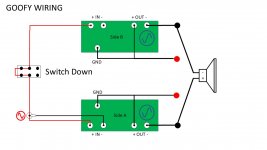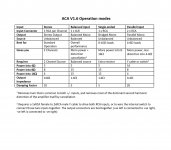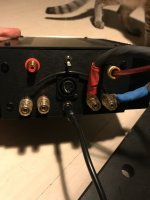too heavy load when used bridged for 4R
for that, use them in parallel mode ( two channels , both inputs and outputs connected in parallel)
Thanks for the prompt response. This is very helpful to know. My speakers I designed and built, and they are a minimum of 3.1 ohm actually (at about 115Hz) and are below 4 ohm between ~85Hz and ~175Hz. At ~950Hz they dip to 5 ohms and rise from there up to ~6.9 ohms at 20kHz.
They are reasonably sensitive - the woofer is rated at 92dB @ 2.83V. They have wonderful quality, pretty deep bass down to about 30Hz; as they are mass loaded transmission lines.
EDIT: I now see Alan's post, and I have another question about the parallel input mode. My preamp has two pairs of main outputs, so am I correct is thinking that using two pairs of RCA interconnects, to connect the two right channel outputs on the Modulus to each input on one ACA, and the two left outputs to each input on another ACA - would yield up to 16W to each of my speakers? I am assuming the speakers would be connected to the two black (outside) binding posts on each ACA? Or, the amp positive and negative binding posts have to be connected together - internally or with outside jumpers?
So, at this point, I think I will go with the AkitkA GT-102 Z4 kit - rated at 35W into 4 ohms and will handle impedances below 4 ohms.
The left channel on my beloved B&K ST-140 died yesterday morning, and this puts more urgency on getting a new amp, that hopefully has the kind of open, spacious, and clear highs of that amp. I have a Schiit Vidar, but it doesn't have what we are looking for, in this area.
Last edited:
@NeilBlanchard
Parallel mode is documented if your ACAs are V1.8, just follow the instructions in the V1.8 build guide step #17 (Amp Camp Amp V1.8 Change Information - diyAudio Guides)
If you have V1.6 ACAs, make a link to parallel the inputs using the XLR socket, then link the Black speaker terminals together, the rear switch needs to be 'down'.
You are paralleling both the inputs together and both the outputs together.
Have a look at post #6514 for more pictures
Alan
Parallel mode is documented if your ACAs are V1.8, just follow the instructions in the V1.8 build guide step #17 (Amp Camp Amp V1.8 Change Information - diyAudio Guides)
If you have V1.6 ACAs, make a link to parallel the inputs using the XLR socket, then link the Black speaker terminals together, the rear switch needs to be 'down'.
You are paralleling both the inputs together and both the outputs together.
Have a look at post #6514 for more pictures
Alan
Attachments
Last edited:
Finally finished. Tried powering on but no signal to speakers. Only one LED came on (in stereo mode) and possibly only one channel / side was getting warm. This is my first diy project so please brace yourselves before viewing the photos. Any tips would be appreciated. I'm going to try following the troubleshooting guide then searching this thread for any further help. Thank you!
philimonmon | Flickr
^ The first photo is a piece of solder that fell off while I was rotating the amp around for photos. Not a good sign. I understand my first soldering attempts were very bad. I suspect multiple cold joints. Not surprised by no signal.
If you'd like to see better photos I can attempt as well. Would just need to switch off from auto on DSLR. I think it's the auto adjustment of aperture making up for the dark and cloudy day. I would have to go manual and choose my own settings and break out the tripod with remote for still capture / slow shutter.
philimonmon | Flickr
^ The first photo is a piece of solder that fell off while I was rotating the amp around for photos. Not a good sign. I understand my first soldering attempts were very bad. I suspect multiple cold joints. Not surprised by no signal.
If you'd like to see better photos I can attempt as well. Would just need to switch off from auto on DSLR. I think it's the auto adjustment of aperture making up for the dark and cloudy day. I would have to go manual and choose my own settings and break out the tripod with remote for still capture / slow shutter.
I'd gently pull it apart and just double check all solder joints. Also, double check the schematic to your work and make sure somethings not backwards.
These things happen.
These things happen.
looks like your power switch solder joints need to be reflowed. I see some on the top of the connection but the switch connector looks like there is no solder on the bottom. High current connection so needs a good bond to that contact point.
Parallel mode should be just fine for lower impedances. If you have V 1.8 just follow the instructions on the rear panel.
Yeah, sure. I looked, I saw, I peed myself. Is there a person in Florida does this for a living?
Bridged With RCA
I’m running 2 ACA’s in bridged with RCA connections. There’s a switch setting for it. It seems to sound the same on the other switch settings. Why is that?
I’m running 2 ACA’s in bridged with RCA connections. There’s a switch setting for it. It seems to sound the same on the other switch settings. Why is that?
You'll need to explain precisely what you're doing before we can answer your question.
Assuming that you not only flipped the switch, but that you also wired your speakers and inputs appropriately for the associated switch position; there are a few options and likely many more. They are not mutually exclusive. Also, it's not supposed to sound different, but with certain speakers and in certain situations, they can sound different as it approaches clipping and/or if you're running bridged/balanced and nulling some distortion. On the flip side, running parallel, you may hear a difference if you run lower impedance speakers at 'higher' volumes and maybe gain a bit of bass.
Look at some previous posts re: how the signal runs through the two amp boards in the various configurations.
tl;dr
- you listen at volumes that don't matter (lower)
- you can't detect the difference sonically, but there is a measurable difference that becomes markedly more different at higher power outputs.
Those are two likely scenarios, but not the definitive answer.
Assuming that you not only flipped the switch, but that you also wired your speakers and inputs appropriately for the associated switch position; there are a few options and likely many more. They are not mutually exclusive. Also, it's not supposed to sound different, but with certain speakers and in certain situations, they can sound different as it approaches clipping and/or if you're running bridged/balanced and nulling some distortion. On the flip side, running parallel, you may hear a difference if you run lower impedance speakers at 'higher' volumes and maybe gain a bit of bass.
Look at some previous posts re: how the signal runs through the two amp boards in the various configurations.
tl;dr
- you listen at volumes that don't matter (lower)
- you can't detect the difference sonically, but there is a measurable difference that becomes markedly more different at higher power outputs.
Those are two likely scenarios, but not the definitive answer.
Last edited:
Thanks for response. Speakers and RCA cables are hooked in accordance with back panel instructions for bridged. Speakers are Zu DW shunted to 8 Ohm. Listening was low level without any measurement equipment.
You still have not provided quite enough clarity for me to be sure. There are two bridged configurations. RCA Bridged, and XLR Bridged. I'll assume you wired it correctly for RCA bridged. See diagrams and post pictures if it's unclear.
Specifically, are you saying that you did not change the speaker wiring from RCA bridged (connected to both black terminals) when you tried the switch in all 3 positions and that you used the single RCA input on Side A for all three positions? In my previous answer I stated the assumption that you had run the amp properly and connected your inputs and speakers accordingly.
If you just hooked it up per Mono RCA Bridged and flipped the switch, then that's a different kettle of fish.
Again, see previous posts re: how the signal is routed at the three switch positions. If I've assumed what you've done (this time) correctly, then it's interesting that with one specific switch position that there was not a very noticeable change. With the switch in the 'down' position, (used for Mono RCA parallel) I think you'd have two inverted phase signals of the same amplitude running to each terminal of your speaker. That's again assuming that the speaker is connected to the two black speaker terminals, and if you're using only the one RCA input connected to "side A". That, in theory, should result in no sound at all. My ACAs are not within reach at the moment, or I'd try it myself.
Edited to add - See below for a diagram of how I think you may have done it, and the expected result.

I'm also assuming you built 1.8, and that you've wired it per the guide / correctly.
I'm assuming a lot.
Perhaps someone more skilled than I should chime in. I feel like I'm missing something critical or just have something completely wrong.
Specifically, are you saying that you did not change the speaker wiring from RCA bridged (connected to both black terminals) when you tried the switch in all 3 positions and that you used the single RCA input on Side A for all three positions? In my previous answer I stated the assumption that you had run the amp properly and connected your inputs and speakers accordingly.
If you just hooked it up per Mono RCA Bridged and flipped the switch, then that's a different kettle of fish.
Again, see previous posts re: how the signal is routed at the three switch positions. If I've assumed what you've done (this time) correctly, then it's interesting that with one specific switch position that there was not a very noticeable change. With the switch in the 'down' position, (used for Mono RCA parallel) I think you'd have two inverted phase signals of the same amplitude running to each terminal of your speaker. That's again assuming that the speaker is connected to the two black speaker terminals, and if you're using only the one RCA input connected to "side A". That, in theory, should result in no sound at all. My ACAs are not within reach at the moment, or I'd try it myself.
Edited to add - See below for a diagram of how I think you may have done it, and the expected result.

I'm also assuming you built 1.8, and that you've wired it per the guide / correctly.
I'm assuming a lot.
Perhaps someone more skilled than I should chime in. I feel like I'm missing something critical or just have something completely wrong.
Last edited:
Could someone tell me what the idss of the jfet should be? I have a matched pair at 7.4 and another pair at 11.0. Do they even have to be a tight match? I have assorted ones in the 8 and 9 range. Thanks for any help, mark
I just received my aca boards from the store. I am going to put them in a diy chassis. I noticed on the boards the center mounting hole and lower left corner mounting hole are grounded. Does this board have to be grounded to the chassis at one of these places or can it float with respect to chassis? Thanks for any help
- Home
- Amplifiers
- Pass Labs
- Amp Camp Amp - ACA

